By RYAN SPENCER
A Cape Cod tradition steeped in true New England grit, winter shellfishing is a seasonal pastime that brings joy and abundance to families and communities.
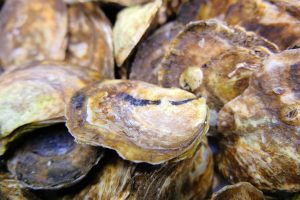
GENE M. MARCHAND/ENTERPRISE
Oysters at Falmouth Fish Market
Sometimes heavy fog will blanket Mill Creek in Sandwich as Carl A. Johansen wades knee-deep into the ice-cold Cape Cod water at low tide on a Sunday morning in the middle of winter.
Other days, the rising morning sun will stretch its warmth over the horizon, casting brilliant colors on the frigid water as Mr. Johansen, with a basket on tow and a rake in hand, scrapes for oysters and quahogs under the boardwalk.
While some might prefer to spend winter mornings in bed, swaddled in blankets and sipping a hot coffee, for Mr. Johansen shellfishing is life. The Sandwich resident, who has more than two decades of experience toughing the wintry cold to gather shellfish, is known around town for generously sharing the fruits of his labor with everyone from neighbors to doctors to town hall employees.
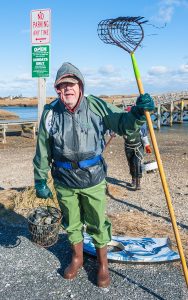
FILE PHOTO JEFF URQUHART/ENTERPRISE
Carl Johansen of Sandwich steps out of the water with his clams this cold morning on the opening day of shellfishing in November 2013.
“As long as I am able to go shellfishing, I know I still have life,” the 88-year-old shellfisherman said. “I enjoy the tranquility and the peacefulness of my surroundings when I’m doing it; I’m getting close to the Maker.”
A hardy Cape Cod tradition, winter shellfishing is a rewarding pursuit—which pays in an abundance of shelled delicacies—for those who are willing to pull themselves up by their wader straps and brave the bitter cold of winter.
“It lifts me up a bit,” Mr. Johansen said. “I say, ‘Hey, I can still do this,’ even though I’m not a spring chicken anymore.”
A lifelong fisherman, Mr. Johansen has “fished in 35-below weather for cod fish” and chalks up his cold tolerance to his Nordic Viking heritage.
“I have a long line of Vikings behind me,” he said. “We’re very cold-oriented, and we layer ourselves.”
But the joys of winter shellfishing are accessible to almost anyone, said Mr. Johansen, who is disabled. All it takes is a little bit of perseverance and some good-old New England grit. From families with young children to retirees, anyone in the Cape Cod area looking for a winter tradition that gets them out of the house and into nature can enjoy winter shellfishing.
“If you can enjoy this as a family thing then you can have something you look forward to at Thanksgiving and Christmastime,” Mr. Johansen said. “The whole family gets in on the act of getting a whole bunch of quahogs and oysters—even soft-shell clams—to eat over the holidays. It’s part of a long tradition that over time has built a bond of unity in the Cape Cod area.
Braving The Cold
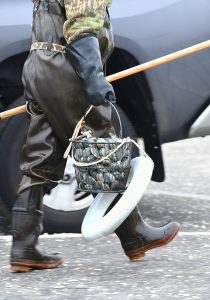
BRENDA M. SHARP/ENTERPRISE
A shellfisherman carries his catch back to his car.
There are a few things anyone braving the cold to harvest shellfish will need, Mr. Johansen said.
First is a rake. Mr. Johansen recommends a handcrafted rake made by the R.A. Ribb Company, a local family-run Cape Cod business.
“It’s a woman and her daughter,” he said. “That’s how they survive.”
The other thing you will need is a pair of long rubber gloves. The kind of gloves that pull up all the way to your upper arm, right to where your shoulder starts.
“You can get them a little shorter, but I don’t recommend that; when you’re out there in the water you want to stay as dry as you can,” Mr. Johansen said.
Then, of course, you will need insulated waders. “Not the stocking type, the ones with shoes with them,” he said. “Not like a fly fisherman would use.”
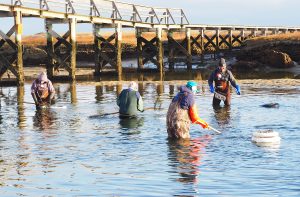
ENTERPRISE FILE PHOTOGRAPH/KAREN B. HUNTER
Fishermen work the waters of Mill Creek on the opening day of Sandwich’s shellfishing season in 2019.
Pro tip: Before Mr. Johansen slides his waders on, he wraps each of his feet in a black plastic trash bag. That way, his feet slide more easily into the boot, and if the waders leak, “you’ll get cold, but you won’t get wet because you’ll be protected by the bag,” he said.
To hold the shellfish, a basket with a float will also be necessary. As will a rope and belt to tie the basket to.
Mr. Johansen also recommends having air-activated hand-warming pouches for those extra-cold days.
“In the middle of winter when you’ve got a little wind chill making it 25 below zero, you’ll really want to use them,” he said.
You will need a shellfish gauge because regulations require shellfish to be of a certain size to be harvested. Mr. Johansen uses PVC pipe. Shellfish gauges can also be bought at your local bait-and-tackle shop.
“I make a real simple gauge for oysters by cutting a two-inch plastic pipe and putting a rope through it,” he said. “If the oyster is less than the inside of the pipe then you can’t keep it. So it makes a good reference guide, and you can do the same thing with quahogs.”
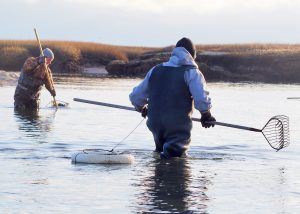
KAREN B. HUNTER/ENTERPRISE
Recreational shellfishermen wade into the waters in search of the season’s first quahogs.
Finally, you will need a shellfish license. On the Upper Cape, shellfish licenses can be bought through your local municipality, either at town hall or the town offices.
“Veterans can go to any town and purchase shellfish permit as the same price as the citizen that lives in the town,” said Mr. Johansen, a veteran who shellfishes in Barnstable and Sandwich.
Remember, Mr. Johansen said, shellfish regulations vary by town, so be sure to check with your local municipality to determine which shellfish areas are open and to brush up on the latest rules about harvest limits and minimum sizes.
Sharing The Bounty
While Mr. Johansen has “always liked doing things in the winter” and “has always enjoyed the cold, for whatever reason,” the real joy of winter shellfishing comes with sharing his bounty, he said.
“It’s called sharing. Somebody shared with me some of the ability on how to do this, and now I have the opportunity to do this and share this fruit of the sea with other people,” he said. “I don’t know how many bags of shellfish I’ve given away. My doctors, my dentist, I have a whole array of people that during the winter months get a bag of oysters or quahogs.”
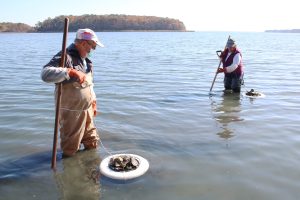
RYAN SPENCER/ENTERPRISE
After shellfishing in November 2020, David and Janet Needham will give some of their oysters to their children, whom they will not get to spend Thanksgiving with in-person due to the pandemic. They have shellfished together for much of their life.
In years past, Mr. Johansen said he has a waiting list of people with whom he has meant to share his shellfish. However, before Mr. Johansen shares his shellfish, he does help himself to a few.
“Every batch that I rake, whether it is quahogs or whether it is oysters, I will eat at least three from each batch,” he said. “That way I know they won’t get you sick, or if I do get sick they don’t go anywhere.”
Other people like to steam quahogs or cook oysters into a stew or stuffing, but Mr. Johansen said he only eats shellfish raw.
“I get a little cocktail juice in there and mmmmm,” he said.
In addition to sharing with neighbors, doctors and many others, Mr. Johansen saves enough oysters for when his son, who lives in Ohio, and his grandchildren come to visit, he said.
End Of The Day
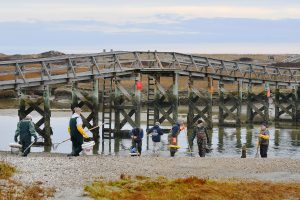
BRENDA M. SHARP/ENTERPRISE
Opening day at Mill Creek attracted a crowd. Not only was it the first day of the 2020 season but it was also the only chance people would have to collect shellfish for the Christmas holiday meal.
The act of shellfishing itself is often not a long activity. Once out on the water, scraping for oysters or digging for quahogs, Mr. Johansen said he can fill his basket to the allowable limit in less than an hour, sometimes closer to half an hour.
Often, he will head out on the water an hour before low tide, to avoid the crowds that arrive at low tide and to find himself a good spot.
“I try to get one spot and work that one spot without moving around other than in a circle,” he said. “My physicality only allows me so much time before I run out of air.”
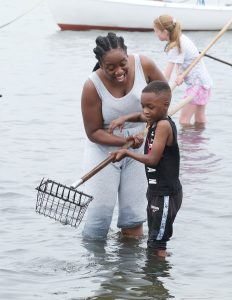
GENE M. MARCHAND/ENTERPRISE
The Mashpee Recreation Department sponsored shellfishing lessons for kids at Seconsett Island Beach earlier this year. Melissa Hutchinson of Mashpee and her 5-year-old son Brayden scoop a clam out of the bay.
Soon his basket is full.
The sun is now well above the horizon, and Mr. Johansen wades out of the chilly water with his harvest.
“When I get home I take my waders off. I take everything off, and I dump everything in the sink and wire-brush every single shell,” he said. “I clean them all up.”
Once the shellfish are all clean and in the refirgerator or freezer, there is only one thing left to do: relax.
“Now it is a more of a relaxing situation,” Mr. Johansen said. “I try to do shellfishing in the morning. That way, when there is a football game on, I know I can watch it, the Patriots or something.”
After a cold morning out on the water, Mr. Johansen said he almost undoubtedly falls asleep partway through the football game.
“I can be sitting here watching it and then I just fall asleep and wake up somewhere around the second or third quarter of the game,” he said.
From the cold morning on the water to relaxing after being chilled to the bone to sharing the bounty, Mr. Johansen said his philosophy is that those who savor the joys of winter shellfishing should share those joys with friends and family.
“If you can bring a friend along and get him involved—whether it is a young friend or an old friend, it doesn’t make a difference if it is a man or a woman—because they will really enjoy it,” he said.

